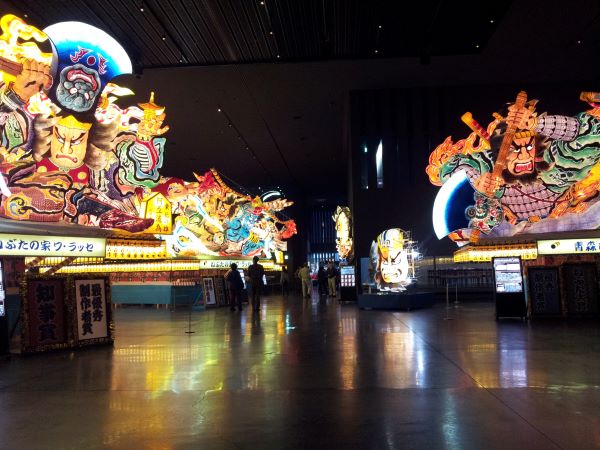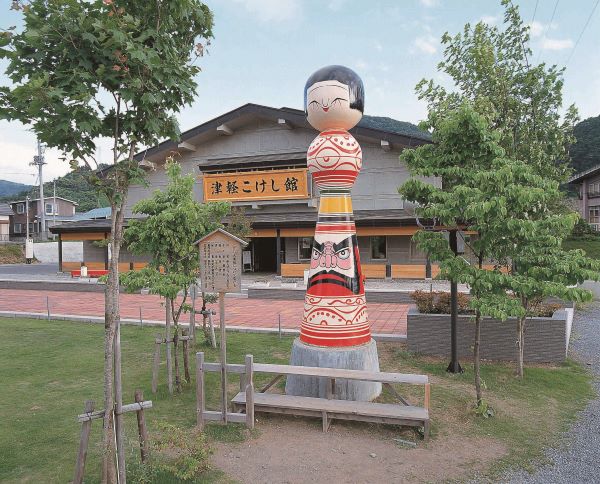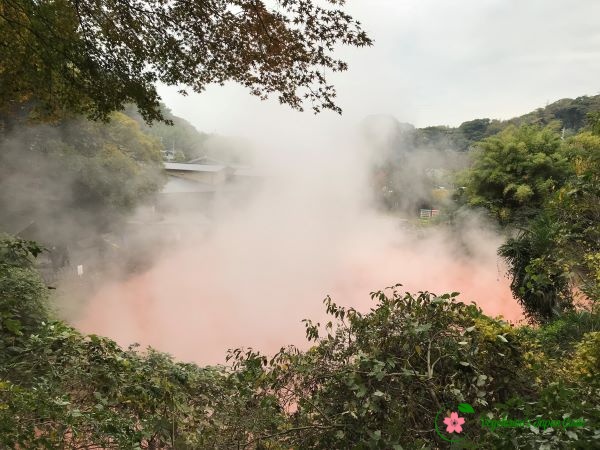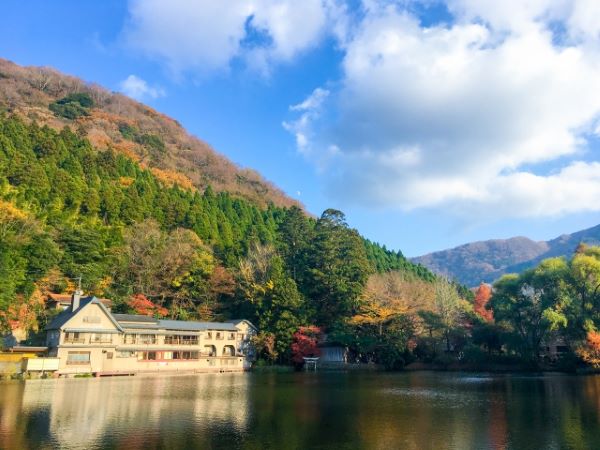When you arrive at Aomori, if you are looking for a destination where you can enjoy the nice hot springs of Japan and magnificent ocean views at the same time, take a short train ride to Asamushi Onsen (浅虫温泉), northeast of Aomori’s city center. Moreover, you can indulge in abundant negative ions in the forest just a few-minute walk away!
As you step out of Asamushi Onsen Station, you will realize that the station’s atmospheres are completely different on the west and east sides.
It is an old onsen town at the station’s east, consisting of ryokans and restaurants. Wearing a kimono and strolling around the township seems to be the perfect way to enjoy the hot spring resort.

On the other hand, at the station’s west, a beach resort that isn’t too far away from the station awaits your visit!
Here is a list of attractions in the onsen town.
- Michi no Eki Asamushi Onsen (道の駅浅虫温泉 ゆ〜さ浅虫)
- Yuno Island (湯の島)
- Sunset beach Asamushi (サンセットビーチあさむし)
- Asamushi Hachimangū (浅虫八幡宮)
- Yachiyama (谷地山)
- Asamushi Dam (浅虫ダム)
- Asamushi Onsen Forest Park (浅虫温泉森林公園)
- Hadaka Island (裸島)
- Vegetarian-friendly Accommodations in Asamushi Onsen
Tip: If you plan to check out and indulge in the hot spring pools at different onsen ryokans and hotels during your visit, check with Asamushi Hot Spring Sightseeing Information Center (浅虫観光案内所) opposite Aomori Railway’s Asamishi Station for the Hot Spring Pass, Asamushi Yufuda (麻蒸湯札). The discounted pass gives you admission to 2 or 3 out of 9 onsen facilities in Asamushi Onsen, depending on which pass you buy. For the 1,000 yen pass, you can choose to visit two hot spring facilities or admission for 2 people. The 1,500 yen pass gives you admission to 3 hot spring facilities or admission for 3 people.
Explore Asamushi Onsen With a Guided Tour
If you prefer to be guided when you visit Asamushi Onsen, how about joining the below tour?
How to Get to Asamushi Onsen
- From JR Aomori Station, change for Aoimori Railway (青い森鉄道) and get off at Asamushi Onsen Station (浅虫温泉駅).
- The train ride will take about 20 minutes.
- For the train line’s timetable, please refer to HERE.
- You can also take the city bus bound for Asamushi Onsen from Aomori Station.
- The bus ride will take around 55 minutes.
Asamushi Onsen’s History
The hot spring source of Asamushi Onsen was discovered by a revered monk called Jigaku Daishi (慈覚大師) in the Heian period (794 – 1185). To support the local economy, the heat from the hot spring was used to steam the hemp used to weave clothes.
In 1190, when another revered monk – Hōnen (法然), the founder of the first independent branch of Japanese Pure Land Buddhism, stopped by Asamushi Onsen, he saw an injured deer using the hot spring to heal its wounds.
Since then, people have followed suit and started bathing in the onsen with medical effects.
The name of the small town was then changed from “麻蒸”, meaning steaming hemp, to “浅虫”, which we are still unsure of the reason (´▽`*). “浅” means shallow, and “虫” means insects. Neither have anything to do with the resort’s history…
Michi no Eki Asamushi Onsen (道の駅浅虫温泉 ゆ〜さ浅虫)
Michi no Eki Asamushi Onsen is a roadside station conveniently located less than a 5-minute walk away from Asamushi Onsen Station.
It is a place to source some of Asamushi Onsen’s local produce and souvenirs. There is also an art gallery and a restaurant on its third floor.
Tip: If you need a toilet, the toilet facilities inside the roadside station are open 24/7. And, as a side note, the standing urinal in the female toilet is for children only. So, ladies, rest assured. You didn’t just accidentally intrude on the male toilets!

Recommended Desserts to Try at Michi no Eki Asamushi Onsen
On a hot day or after a hot spring session, get one of their most famous Black Current Soft-Serves (黒房すぐりソフトクリーム), which has a sweet and sour taste to cool down!
Another dessert dish that may interest you is the Tsuchiya’s Apple Pie (土屋さんのりんごパイ). Inside the puff pastry are crispy apples packed tightly inside. Simply feel the weight of the pie. You will realize how many apple slices are underneath the pastry!
Observatory Bathhouse Badakayu (展望浴場「はだか湯」)

When the weather becomes chilly, you might want to head to Michi no Eki Asamushi Onsen’s observatory hot spring bathhouse instead of strolling on the beach shore.
The five-story roadside station has an onsen facility on its top floor. It gives you a wide view of Mutsu Bay (陸奥湾) with the symbol of Asamushi Onsen, Yuno Island, emerging from the seemingly endless ocean.
The scenery of sunset is also superb from here!
Tip: Free coin lockers are available to store valuables at the Onsen facility.
Observatory Bathhouse Badakayu’s Opening Hours and Cost
- The opening hours are from 7 am to 9 pm.
- The last admission is at 8:30 pm.
- The cost is
- 360 yen for adults
- 160 yen for elementary school students
- 70 yen for children from the age of 2 – 6
- Remember to bring your amenities and bath towels. Otherwise, you can purchase these from the roadside station when you get there.
Michi no Eki Asamushi Onsen’s Opening Hours and Access Information
- The souvenir corner is open from 9 am to 7 pm.
- From December to March, the opening hours are shortened to 6 pm.
- The restaurant is open from 9 am to 7 pm. From December to March, the opening hours are shortened to 6 pm.
Click HERE to return to a list of attractions in Asamushi Onsen.
Yuno Island (湯の島)
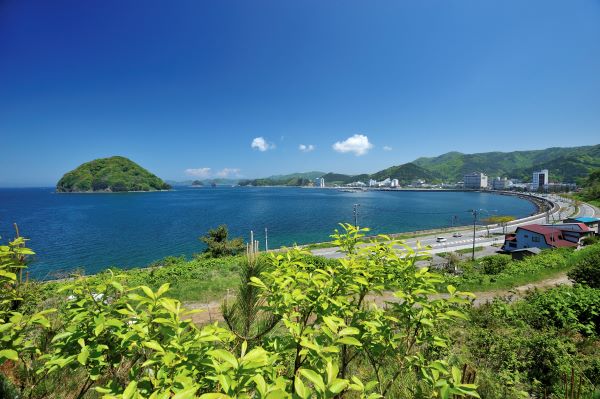
The symbol of Asamushi Onsen, Yuno Island or ‘Yunoshima’ in Japanese, is located 800 meters northwest of Asamushi Onsen.
The island is covered by dogtooth violets. When the flowers are blooming in mid to late April, a Dogtooth Violet Festival (湯の島カタクリ祭り) is held. This is also the only time of the year when boats are at the port, ready to pick up customers and fetch them to the small island.
Yuno Island was determined to have been created by volcanic activity around 6 to 7 million years ago. On the side facing Asano Onsen, there is a small shrine with the god of wealth, Benzaiten (弁財天), enshrined.
If you ever get onto Yuno Island, you might also find many black pines now. Those pine trees were planted around 1897 when 2,000 saplings were transported to the island to increase the variety of greeneries.
Spot the Rare White Dogtooth Violet Flower
As you trek through Yuno Island to admire the pink-purple dogtooth violets on the ground, remember to see if you can spot a white dogtooth violet flower. The probability of getting a white dogtooth violet is one in 10,000. So if you do find one, it means some lucky thing may happen to you soon!
And just to be clear, it is the flower in white color that you are looking for. This includes the stamen. The ones with white petals but purple stamen are not good enough.
Along with the flowers of dogtooth violet, in the same season, there will be other plants blooming as well. See which kind of flower you like the best!
Important:
☛ The top of the island has an elevation of 132 meters. So the promenade with dogtooth violets growing at its sides consists of some deep slope.
☛ Boats won’t depart the port if it is determined that the weather condition is not good enough to head out.
Interesting fact: Yuno Island is actually owned by the former Mayer of Aomori.
When is Dogtooth Violet Festival Held
The Dogtooth Violet Festival at Yuno Island is usually held from the beginning to late April. The last few events were held on the below dates.
- 2023: Unannounced
- 2022 (canceled): the 2nd to the 21st of April
- 2021 (canceled): the 4th to the 21st of April
- 2020: the 4th to the 21st of April
- 2019: the 6th to the 21st of April
- 2018: the 7th to the 22nd of April
The cost of the boat is 1,000 yen for a return trip. Elementary school students receive a discount of 500 yen. The boat trip is free for pre-school children.
The guided trip on the island will take around 1 hour for a return trip to the island’s top.
Sunset Beach Asamushi (サンセットビーチあさむし)
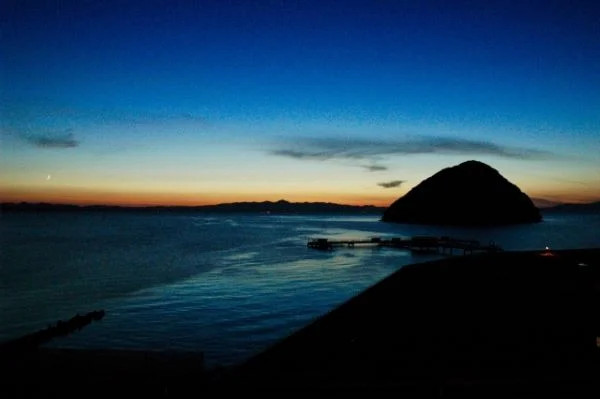
Opposite Yuno Island is the artificial sandy beach that was completed in 1998.
The 1.6-hectare beach has a designated swimming area of 1.9 hectares. Shower rooms and toilet facilities are also available in the lawn area across the promenade.
Like its name, it is the perfect place in Asamushi Onsen for a relaxing stroll on the beach shore with a stunning sunset view.
The Opening Periods of Sunset Beach
- The Sunset Beach Asamushi is open as a seaside park from early April to October.
- This is when the toilet facilities are available for public use.
- You can enjoy SUP or kayaking during this period of the year.
- From late July to late August, the beach is also open for swimming, with lifeguards watching for your safety.
- Free shower facilities with warm water are available during this period.
- Change rooms and coin lockers are also usually available.
- In 2022, the period was from the 16th of July to the 21st of August, from 9 am to 4:30 pm.
As boats aren’t operating during other times of the year to carry you to Yuno Island, you can paddle your way through if you want to get closer to the island!
Besides Yuno Island, your guide will also take you to other small islands scattered offshore Asamushi Onsen.

On the other hand, this enormous wooden chair will catch your attention before you even head to the beach. Unsure of its purpose, the chair just creates a somewhat humorous scene when you combine it with the view of the ocean shining in the setting sun (´▽`*).
Asamushi Hachimangū (浅虫八幡宮)
Asamushi Hachimangū is a shrine that was first erected in 1282. The current main worship hall was rebuilt in 1915. The locals treated the gods enshrined here as their guardian gods. Furthermore, citizens of Aomori Prefecture travel to Asamushi Onsen as this is the closest Hachimangū to them.
The shrine is conveniently located just a 5-minute walk away from Asamushi Onsen Station.
Yachiyama (谷地山)
If you want a complete view of Asamushi Onsen that is similar to the photo, you can head up to the top of Yachiyama, a mountain with an elevation of 180.7 meters. It is so small that it can’t be found on Google Maps (´▽`*).
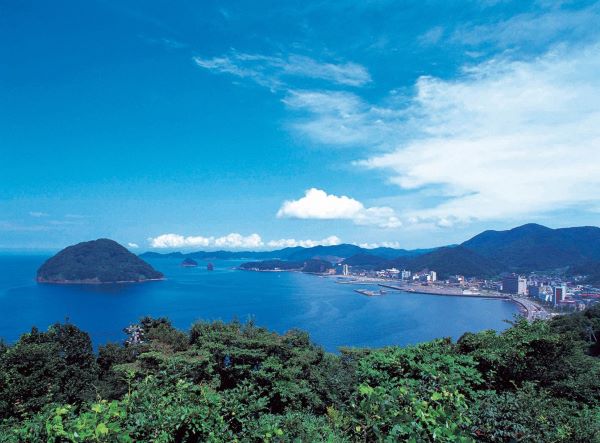
Along the way, you will be guided all the way to the summit by the 88 Buddha statues that represent the 88 main Buddhas in the temples on the Shikoku Pilgrimage Route (四国八十八カ所). Each Buddha statue has the temple’s name in Shikoku and its pilgrimage route number carved underneath.
There is also a monument representing Emperor Meiji once adorned the scenery from Yachiyama!
Getting to the top of Yachiyama only takes around 40 to 60 minutes. There are a total of three trailheads, with the one closest to Asamushi Onsen Station at Asamushi Hachimangū Shrine. If you plan to drive, you can park at Mutakuji Temple’s (夢宅寺) car park, as the shrine doesn’t have a parking lot.
The trailhead is located close to the shrine’s worship hall. So climb up the stairs in front of its torii gate, and off you go!
The hiking trail consists mainly of wooden staircases and earthen roads. It is relatively well-maintained but can be slippery when wet.
You can refer to the 5th photo of the Instagram post for the map. The hiking course is marked in brown on the left of the map. For the mountain trail, you can also refer to the trail marked in brown at the top left of THIS MAP.
The promenade in the shape of a loop is where the 88 Buddha statues are placed. A lookout is located not too far away from the convergence of the trail from Asamushi Kōyasan Mutsugokokuji Temple (浅虫高野山 陸奥護国寺). It is the branch temple of the World Heritage, Kōyasan in Wakayama Prefecture.
Passing the convergence, you will start seeing the Buddha statues placed along the promenade. At the summit, you can snap a photo like the one above.
Following the mountain trail, when you see the 64th Buddha statue, a statue of Amida Buddha, you can head straight to head down to an Inari Shrine (稲荷神社) or turn right to Asamushi Kōyasan Mutsugokokuji Temple.
Asamushi Dam (浅虫ダム)
Asamushi Dam is a hydraulic dam that was completed in late 2002. Unlike many dams in Japan situated in deep mountains far from the sea, this one is unusually close to the ocean. From the observation deck up on the hill at one side of the dam lake, you can also see the Mutsu Bay (陸奥湾) afar!
Walking on the 2.1 km promenade around the dam lake, you will encounter a few statues and paintings on the side of Hotaru Bridge that represent the area. For example, that giant bug in the Instagram post isn’t a cockroach but a firefly. Underneath it is two Japanese serows.
How to Get to Asamushi Dam
It is a 15-minute walk from Asamushi Station (浅虫温泉駅).
Asamushi Onsen Fireflies Viewing Event (浅虫温泉ホタル観賞会)
In July, at Asamushi Dam, numerous fireflies will fly around the waterfront at night. So each year, a viewing event is held.
If you are staying overnight at Asamushi Onsen, your accommodation provider will most likely be able to fetch you to the dam lake to participate in the event. So check with them when you check in (or at the time of booking)!
The dam lake is known as Firefly Lake (Hotaruko, ホタル湖). It is a rare place where three different types of fireflies call it home. But as each type of firefly has a slightly different season (usually one after another), it is unlikely that you can see all three types of fireflies simultaneously.
Tip: To avoid fireflies from stopping on your face, you can get one of the head nets from the local shops.
Asamushi Onsen Forest Park (浅虫温泉森林公園)
Another place great for some light hiking is Asamushi Onsen Forest Park which is open from 9 am to 9 pm from the end of April to October. It is around a 20-minute walk from Asamushi Onsen Station.
Throughout the 10 km promenade, you will have plenty of opportunities to spot wild birds flying between the trees surrounding the trail. Close to the park’s office, a Mutsu Bay Lookout is another awesome spot to see the sun slowly disappearing from the horizon. When the weather is good, you can see as far as Tsugaru Peninsula (津軽半島) and Shimokita Peninsula (下北半島).
At the end of dogtooth violet season, the hydrangeas will bloom on one side of the park. In summer, it is another spot in Asamushi Onsen where you can find fireflies dancing at night.
The 10 km promenade will lead you to the top of Mt. Takamori (高森山) at 386.3 meters. If that is your goal, there will be some steeper slopes you will be hiking through. It will take around 2 hours to reach the summit at a relaxing pace.
In autumn, the forest around you will be colored in vibrant color.
For the mountain trail, refer to the trail marked in brown at the bottom right of THIS MAP.
Tip: It is probably better to start hiking from the trailhead close to the park’s car park at the park’s office. If you head into the park from Asamushi Aquarium (青森県営浅虫水族館), parts of the promenade closer to the trailhead are less maintained.
Hadaka Island (裸島)
At the north of Awamushi Onsen, a 33-meter tall rock stands close to the shore. As no trees grow on the rock, people called it Hadaka Island, which means ‘a naked island’.
The rock was a part of Japan’s main island ages ago. But over the years, the waves have eroded the path. So nowadays, parts of the path to the rock are underwater during high tide.
The Sad Story of Hadaka Island
Once upon a time, a mother left her baby in the shade of a tree and worked in the field. Suddenly, a Steller’s sea eagle came and picked her baby up, flew away, and rested at the top of Hadaka Island.
Realizing what happened, the mother was desperate to bring back her child. She attempted to climb up the rock with her bare hands. As she scratched the rock’s smooth surface, her hands started bleeding, and the side of the rock was dyed with her blood.
Fortunately, she was successful in retrieving her lost baby. This is why there are cracks in the rock. They are the traces of the mother’s effort.
Vegetarian-Friendly Accommodations in Asamushi Onsen
While we haven’t looked into all accommodations in Asamushi Onsen, the below two are the most famous and will do their best to cater to your special dietary requests.
Also, both provide pick-up and drop-off services from/to Asamushi Onsen. If you require the service, please let the hotel know in advance.
Nanbuya Kaisenkaku (南部屋・海扇閣)
The highrise hotel is just a 3-minute walk from Asamushi Onsen Station. The hotel is known for its top-class service and food that satisfies Japanese guests, who usually are pickier!
If you don’t mind sleeping on the traditional futon bed, which can be hard to sleep on, we recommend booking their Japanese-style guestroom. This is because all of their Japanese-style rooms face Mutsu Bay, allowing you to enjoy the magnificent view anytime during your stay.
Furthermore, all of their Japanese-style rooms have a sunken kotatsu. A kotatsu is a low table with a heater attached. In winter, the Japanese usually use a futon to cover the table and place their legs underneath the table with the heater turned on to keep them warm.

A sunken kotatsu is an advanced version of kotatsu. It is built into the floor. So instead of sitting with your legs stretched out, which may give you back pain after a while, the experience is just like sitting on a chair! In other words, the type of kotatsu, which is also known as Hori-gotatsu (掘りごたつ), gives you more comfort.
Tip: Ask the hotel staff if they can give you an extra futon to sleep on. Two futons are always softer than just one.
What is Special About Nanbuya Kaisenkaku?
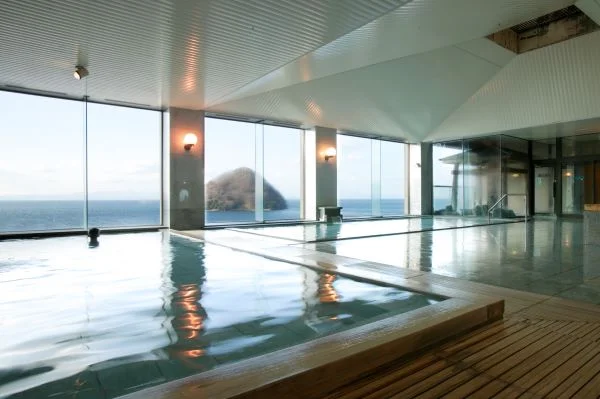
One of the main selling points is its observatory bathing area. Located on the hotel’s 9th floor (the top floor), you can get an even better view of Mutsu Bay than the roadside station!
One thing to be aware of is there is no private onsen pool. Their guestrooms, however, all come with a bathroom with natural hot springs coming out from the facet of the bathtub (albeit they can be small).
If you don’t plan to stay overnight here, you can still utilize the facility from 12 pm to 2 pm. The cost is 1,000 yen for adults, 500 yen for children.
Another selling point of Nanbuya Kaisenkaku is the Japanese Shamisen live performance on most nights. Shamisen is a traditional Japanese guitar. The performer plays the local Tsugaru-style music for 30 minutes at 8:30 pm in the lobby on the 1st floor.
Tsubakikan (椿館)
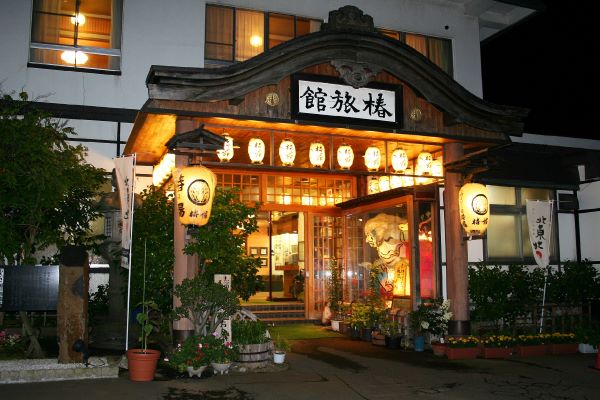
Tsubakikan is one of the oldest ryokans in Asamushi Onsen and boasts customer service quality. It is also the ryokan where Emperor Meiji stayed when visiting Asamushi Onsen.
Other famous people who have stayed at Tsubakikan include Dazai Osamu (太宰治), a Japanese writer who was active in the early 20th century, and Munakata Shikō (棟方志功), a well-known woodblock printmaker in the Shōwa period.
Munakata Shikō, born in Aomori, had visited Tsubakikan each summer with his family since 1941. Many artworks were created during his stay. When you visit Tsubakikan, you can see his works left to the Ryokan. These are the paintings that you will never find in art museums such as Munakata Shikō Memorial Hall (棟方志功記念館)!
Although we said it is an old ryokan, don’t mistake it as accommodation with old facilities. The interior of the ryokan has been maintained and renovated to ensure comfort during your stay.
But one thing to watch out for when you make your reservation is that not all their guestrooms have a bathroom. So if you hate sharing facilities with others, pick a room that does come with one.


Besides the indoor and outdoor onsen pools, Tsubakikan also has a private hot spring pool that you can rent from mid-November to April.
Also, there is an onsen drinking fountain that has drinkable hot springs coming out of the tab. If you want to taste their hot springs, follow the instructions so you don’t exceed the recommended intake and/or drink it at the time of the day that isn’t recommended.
For more information, please refer to their website HERE.
How to Get to Tsubakikan
- From Asamushi Onsen Station, it is around a 6-minute walk.
- In winter from late December to mid-April, if you are flying into Aomori Prefecture and are staying at Tsubakikan, the ryokan can pick you up from and/or drop you off at the airport between 3:30 pm to 5 pm. Please let them know if you would like to be picked up/dropped off.
Asamushi Onsen Fireworks Festival (浅虫温泉花火大会)
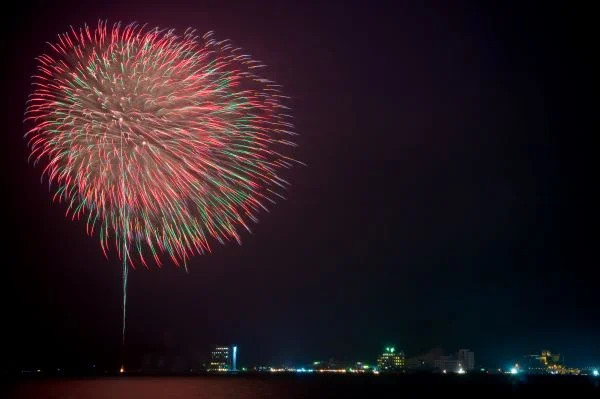
On the 1st of August each year, the night before the Aomori Nebuta Festival (one of the Three Great Festivals of Tōhoku (東北3大祭り)) is held, thousands of fireworks will be launched into the night-time sky at the beach shore of Asamushi Onsen.
The festival, which has been held for more than 70 years, will have the venue open for people to secure their spots at 1 pm for the fireworks taking place at 7:30 pm.
If you don’t want to spend the whole afternoon just waiting for the fireworks to start, you can also pay 1,000 yen for the VIP seating on the day (around 1,200 tickets available).
Asamushi Onsen Nebuta Festival (浅虫温泉ねぶた祭)
Another festival held at Asamushi Onsen related to the Aomori Nebuta Festival is the Asamushi Onsen Nebuta Festival. But instead of holding it annually, it is held bi-annually in the onsen town!
In both mid-July (from 6:30 pm to 9:30 pm) and mid-August (from 7 pm to 9 pm), 4 giant Nubuta floats will be parading around the village and end at Asamushi Onsen Station.
If you are staying at Asamushi Onsen for the night, check with your hotel for how to rent out the free Nebuta costumes!

Find out Where Else to Go in Aomori
Aomori City, the capital of Aomori Prefecture, has a wealth of beautiful nature, such as the Hakkōda mountain ranges and Mutsu Bay. Stunning scenery can be adorned throughout the year. In the fall, it is time to find out your favorite kinds of apples!
The city also has a couple of cultural heritages to enjoy a different side of Japanese culture.
For more information, please refer to our article on Aomori!


